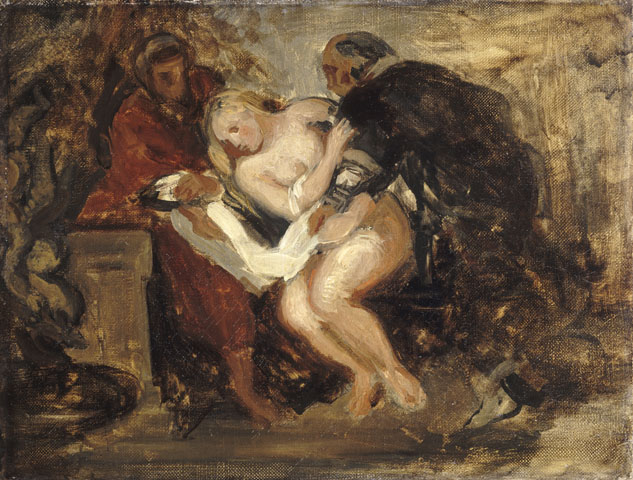Fr : version française / En: english version
mheu, Historical Museum of the Urban Environment
Susanna and the Elders, Chaste Susanna
Eugène Delacroix

19th century
oil on canvas
Lille, Palais des Beaux-Arts
© RMN / Philipp Bernard
View this work in the exhibition Bathing
The work
Delacroix's Susanna is chaste—at least that is the subtitle of this sketch for a picture that was never actually painted. This work is reminiscent of a sketch of a pietà kept in the Louvre and painted in 1837; the final painting, in which the composition is reversed, hangs in the church of St Denys du Saint-Sacrement in Paris. In both pictures, Delacroix has painted a shape—vegetable or mineral—that conjures up the curtain in a theatre. In the St Denys work, the curtain opened onto a weeping Virgin Mary, her arms spread out like a cross. Here it opens onto a scene describing an act of real aggression: the elders are about to rape the woman. The chaste Susanna appears to abandon herself, as if she were dead, as a result turning the elders into undertakers and the painting, a peculiarity of its composition, into a strange Deposition from the Cross.
The artist
Born in Charenton-le-Pont in 1798, Eugène Delacroix is the French Romantic painter and one of the greatest artists of the 19th century. He was the son of a politician, a member of the National Assembly and later a prefect - but a rumor circulated that he was in fact the natural son of Talleyrand who always looked after him. He was a pupil of Guérin, a good teacher but a mediocre neoclassical painter. A great admirer of Rubens, Velázquez and Veronese, he very quickly gave priority to color and gave short shrift to drawing, in contrast to his contemporary Jean-Dominique Ingres, the other artistic icon, wrongly considered a neoclassicist. Success came quickly: his first significant works (Dante and Virgil in Hell, 1822, and The Massacre at Chios, 1824) were bought by the State. In 1832, Delacroix began a long trip to Morocco. On his return, he devoted himself to commissions for large-scale decorative works, for the King's Chamber at the Palais Bourbon, the Palais du Luxembourg, the Louvre and the church of St Sulpice. At the height of his fame, he moved in high social circles, was elected to the Institut de France in 1857 and founded the Société des Beaux-Arts in 1862, two years before his death.